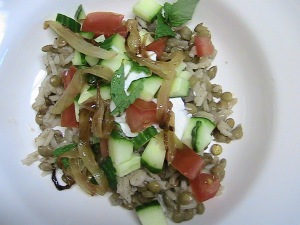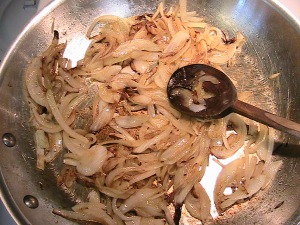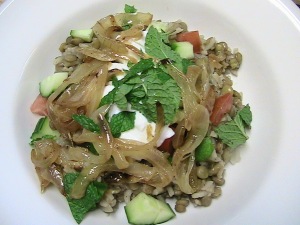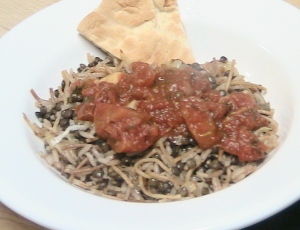One of the great joys of my life thus far has been feeding my child. After a rocky start, I was able to nurse Mimi for the first year of her life. While there were many, many times when that process was painful, tedious, or inconvenient, it was nevertheless a miraculous experience, a period marked by a feeling of intense physical closeness to my child that I long for today. I can remember looking into her contented face as she nursed and being so often struck by a sense of real accomplishment and even power. Here was something I could do well for her — something nourishing and essential, something ancient and mysterious. (I was also often amazed by her tenacity and strength as she nursed, but that’s another story.)
When the time came for Mimi to eat solid food, I was excited to make simple pureés for her — mostly organic, usually seasonal. An early favorite was a combination of plain yogurt and fresh mango that we playfully called “mango-dango.” Throughout this next phase of eating, I spent many happy afternoons steaming and pureéing Asian pears, green peas, Pink Lady apples, even quince. I roasted and mashed eggplant and sweet potatoes. I smashed bananas, strawberries, and peaches as well as red beans, lentils, and boiled edamame. Later, when her pretty little teeth appeared, I steamed green beans, broccoli, and carrots, cut them up, and served them with hummus. I fed her salty bacon and smoked salmon, quinoa and couscous. I topped baked potatoes with pesto, a practice that eventually became mandatory. One happy memory is of my six-month old daughter, to the surprise and delight of my mother-in-law, greedily gobbling up a plateful of steamed asparagus at a favorite restaurant in Michigan. We ordered some extra and she polished that off as well. Even the waitress was impressed.
Mimi has always been a fairly adventurous eater. She will eat almost anything that she sees her parents eat. When she was tiny, the only foods that she refused outright were infant cereals, commercial baby food, and, well, avocados. We all have our culinary quirks.
But that quirkiness works both ways. She has long had a passion for kalamata olives. When she was just over a year old, she shared them for first time with our friend Laura at a dinner party, Laura biting off tiny pieces and feeding them to Mimi as if she were a baby bird. She’s loved them ever since. Even now, I have to hide the olive jar in the fridge or my child will insist upon having an “olive snack.”
Before Mimi was born, I resolved that she would not be a picky eater, as so many children are. I was keenly aware that the odds were against us. I’m not sure when this happened, but at some point in American history, someone decided that children don’t like to eat the same foods as their parents and, moreover, that “adult” food was not even really appropriate for kids. Of course, a whole new market opened up to accommodate this trend: children’s food. These foods are marked by uniformity and infantile product names — “Go-Gurt,” “Captain Crunch,” ”Snackables,” “Spaghetti-O’s.” None of it is any good.
This trend logically expanded into American restaurants. Just try to find one that does not have a separate set of dishes prepared for children. I’m not the first person to point out the fact that the phenomena known as the “Children’s Menu” reinforces the idea that kids need to eat their own special food. The problem is that this food is never particularly special. I suppose it makes some sense to offer smaller portions of food to children, who usually don’t eat very much anyway. However, most children’s menus dumb down food, providing only a handful of blandly predictable items: grilled cheese, hot dogs, pizza, macaroni & cheese, chicken fingers — sometimes a hamburger and always french fries. It’s generally impossible to determine what kind of restaurant you are in by surveying the children’s menu. In the US, I’ve been to Indian restaurants that serve hot-dogs; French restaurants that offer hamburgers; Italian restaurants that feature chicken fingers. (Isn’t it interesting that restaurants in India, France, and Italy seldom have children’s menus? Kids eat what their parents do, just less of it.)
Thus, tastes and habits are created. Presented with an array of “appropriate” foods, kids pick up their forks and they eat. But not adult food. No, thank you. Children always strive to meet our expectations — even when those expectations are impossibly low.
Interestingly, it is possible that food preferences become instilled even earlier than toddlerhood. Some researchers theorize that amniotic fluid — that watery substance that nurtures and protects the aquatic fetus during gestation — changes flavor depending upon what a mother eats. The flavor of breast milk varies similarly. Taste, then, might be developed prenatally, at least initially, and probably long before solid foods are introduced. If true, then children’s food manufacturers have already tailored the tastes of at least one generation of American eaters. It occurs to me that the menus of several major American food chains support this theory. How different are the adult and children’s menus at Applebee’s?
Back when I was pregnant and nursing, I was especially concerned with eating as many different things as I could so that Mimi’s palate would be as varied as possible. I liked to imagine Mimi, tucked away inside of me, wondering what new flavor experience would come next. I made sure to eat a lot of broccoli, hoping to raise a lover of that unfairly maligned vegetable. It seems to have worked. Mimi likes her little trees.
Now that she’s older, Mimi will often ask me what’s for dinner and then, when she finds out what we’re having, she asks a follow-up question: “Do I love that?” Usually, I’m able to assure her that she does love whatever it is that we’re having, but I’m not a fool. I’ll know that eventually, there will be some resistance. At some point, she’s likely to wonder why she eats foods that other kids do not. Worse, she’ll wonder why we never feed her the special foods for kids that so many of her friends get to eat. From a child’s point of view, if there are special foods and menus in stores and restaurants, there must also be special foods and menus at home.
And, usually, there are.
But not at our house, at least not preprocessed “special” foods. We’ve tried to protect Mimi from the tyranny of low expectations. In restaurants, she either shares with us or we request a small plate of something from the regular menu. Decent restaurants will usually cooperate. It’s easier at home. Except when she was very small, she has always eaten what we do. Even her baby meals bore a strong resemblance whatever Jim and I were eating for dinner — softer versions of the family meal. One of the first dishes that we all enjoyed together was Megadarra, a wonderful lentil and rice dish from the Middle East. Topped with yogurt, carmelized onions, and a small salad of cucumbers, tomato, and mint, the dish is complex without being confusing. It is meatless, healthy, delicious, and visually appealing. Minus the salad, it’s a perfect first “real” meal for a small child. There’s nothing to choke on and it can be rendered appropriately mushy with the addition of extra yogurt. The lentils are earthy and the basmati rice and onions, together with the cinnamon and allspice, provide a nice bit of sweetness. I served it to Mimi first without the salad and, later, with the salad on the side so she could gobble up the small pieces with her fingers. Now, she eats the dish exactly as we do and just as happily.
It’s an old standard at our house, one that satisfies both young and old alike.
Megadarra
2 white onions, thinly sliced
1 tbs. butter
3 tbs. olive oil, divided
1 white onion, diced
2 cloves garlic, finely minced
1 tsp. ground allspice
1 tsp. ground cinnamon
1 1/2 tsp. ground cumin
3/4 cup brown lentils
4 cups water
1/2 cup basmati rice
1 English cucumber, diced
2 tomatoes, seeded and diced
1 cup 2% Greek yogurt
1/2 cup mint leave, roughly chopped
salt & pepper
First, caramelize the onions. In a large frying pan, melt butter over medium-high heat. Add olive oil and onions and saute until the onions are soft and brown, about 10 minutes. Remove from heat and season with salt and pepper. Set aside.
In a large Dutch oven, heat remaining olive oil over medium-high heat. Add onions and saute until soft. Add garlic and continue to saute until fragrant. Add allspice, cinnamon, and cumin. Stir constantly for one minute. Add water and lentils. Cover and bring to a boil. Reduce heat to low and simmer for 20 minutes until the lentil begin to get soft, stirring occasionally. Add rice and more water (if necessary) to cover). Bring back to a boil and simmer, covered, for another 20 minutes, until the rice is soft and the water has evaporated. Stir only as needed.
Remove from heat. Season with salt and pepper, stirring very gently. Serve the lentils in bowl topped with onions, cucumber, tomato, mint, and yogurt.




 Last night, I made a traditional Egyptian dish called Kosheri from a recipe found in the Ottolenghi cookbook. Kosheri is similar to another popular Middle Eastern dish made with rice, lentils, and caramelized onions called Megadarra (also called Mujadra). Megadarra is typically served with a yogurt, tomato, and cucumber salad; we eat it often in the Summer. Kosheri, however, features a tomato sauce on the side, which makes it great for the cooler months, when tomatoes and cucumbers are not at their best.
Last night, I made a traditional Egyptian dish called Kosheri from a recipe found in the Ottolenghi cookbook. Kosheri is similar to another popular Middle Eastern dish made with rice, lentils, and caramelized onions called Megadarra (also called Mujadra). Megadarra is typically served with a yogurt, tomato, and cucumber salad; we eat it often in the Summer. Kosheri, however, features a tomato sauce on the side, which makes it great for the cooler months, when tomatoes and cucumbers are not at their best.





